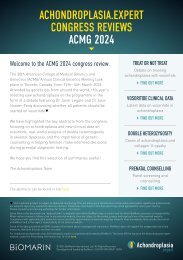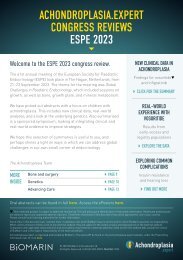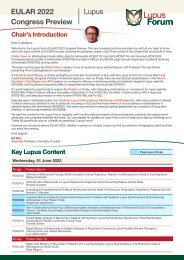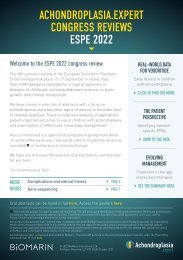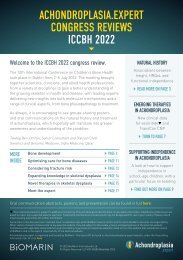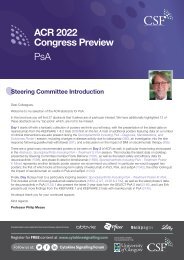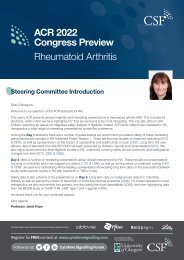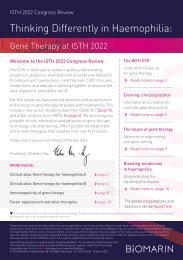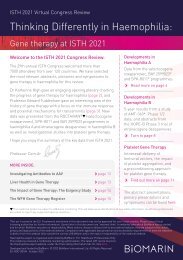ACMG 2023 Congress Review
March 2023 saw the Annual Clinical Genetics Meeting take place in Salt Lake City, US, attended by delegates from around the world. Across more than 50 educational sessions, presenters shared news about the latest developments in medical genetics.
March 2023 saw the Annual Clinical Genetics Meeting take place in Salt Lake City, US, attended by delegates from around the world. Across more than 50 educational sessions, presenters shared news about the latest developments in medical genetics.
You also want an ePaper? Increase the reach of your titles
YUMPU automatically turns print PDFs into web optimized ePapers that Google loves.
ACHONDROPLASIA.EXPERT<br />
CONGRESS REVIEWS<br />
<strong>ACMG</strong> <strong>2023</strong><br />
Welcome to the <strong>ACMG</strong> <strong>2023</strong> congress review.<br />
March <strong>2023</strong> saw the Annual Clinical Genetics Meeting<br />
take place in Salt Lake City, US, attended by delegates<br />
from around the world. Across more than 50 educational<br />
sessions, presenters shared news about the latest<br />
developments in medical genetics.<br />
Year on year the volume of data around achondroplasia<br />
at meetings like this is growing, alongside increasing<br />
awareness and understanding of the condition.<br />
We have chosen a handful of key abstracts presented<br />
in the session on clinical genetics and therapeutics.<br />
This includes data from the Phase 2 and 3 clinical<br />
trials of vosoritide , as well as real-world observational<br />
data that shines a spotlight on quality of life and the<br />
surgical burden associated with achondroplasia.<br />
We hope you will enjoy the selection summarised<br />
for you here.<br />
The Achondroplasia Team<br />
VOSORITIDE: CLINICAL DATA<br />
News from the Phase 2<br />
and 3 trials, including a<br />
look at the persistence of<br />
growth-promoting effects<br />
CLICK TO FIND OUT MORE<br />
REAL-WORLD DATA<br />
An update on early<br />
experience with vosoritide<br />
in clinical practice<br />
JUMP TO THE DATA<br />
ACHONDROPLASIA:<br />
NATURAL HISTORY<br />
Examining QoL, and the<br />
surgical burden associated<br />
with achondroplasia.<br />
READ MORE HERE<br />
The abstracts can be found here.<br />
This medicinal product is subject to additional monitoring. This will allow quick identification of new safety information. Healthcare professionals<br />
are asked to report any suspected adverse reactions. Treatments mentioned in this document may not be approved for use in your country.<br />
Please consult local licensing authorities for further information.<br />
Some links in this document are “external links” to websites over which BioMarin has no control and for which BioMarin assumes no responsibility.<br />
When visitors choose to follow a link to any external website, they are subject to the cookie, privacy and legal policies of the external website.<br />
Compliance with applicable data protection and accessibility requirements of external websites linked to from this website falls outside the control<br />
of BioMarin and is the explicit responsibility of the external website.<br />
Achondroplasia.expert is organised and funded by BioMarin. The latest API be found on the Achondroplasia.expert website, under the Prescribing<br />
Information tab. Or click here.<br />
© <strong>2023</strong> BioMarin International Ltd.<br />
All Rights Reserved. EU-VOX-00819 March <strong>2023</strong><br />
1
Achondroplasia.expert <strong>Congress</strong> <strong>Review</strong>s: <strong>ACMG</strong> <strong>2023</strong><br />
VOSORITIDE: CLINICAL DATA<br />
Vosoritide downregulates FGFR3 signalling and is a potent stimulator<br />
of bone growth. It is approved for use in children with achondroplasia<br />
on the basis of a Phase 3 study which demonstrated significant<br />
improvements in AGV versus placebo.*<br />
3-year data from the Phase 3 extension study<br />
were presented by Hoover-Fong et al. After<br />
completion of the placebo-controlled portion of<br />
the study, 119 children were enrolled into the<br />
extension, where they all received open-label<br />
vosoritide 15 μg/kg/day. This created a<br />
population of those with continued vosoritide<br />
treatment (n=58), and those switched from<br />
placebo to vosoritide (n=61). AGV and body<br />
proportion ratio were analysed to assess<br />
efficacy of vosoritide. The results show<br />
that in children randomised to vosoritide,<br />
mean cumulative AGV improved from 4.26<br />
to 5.66 cm/year from baseline to Week 104,<br />
and was maintained at 5.57 cm/year at<br />
Week 156. In 34 children with available<br />
follow-up at Week 182, AGV was maintained<br />
at 5.45 cm/year, and mean upper-to-lower<br />
body segment ratio improved with a change<br />
from baseline of –0.03 at Week 52 to -0.13<br />
after 3.5 years on treatment. In children<br />
who switched from placebo to vosoritide<br />
after 52 weeks, cumulative AGV improved<br />
from 3.77 cm/year to 5.45 cm/year from<br />
baseline to Week 104, and was maintained<br />
at 5.43 cm/year at Week 130. Most adverse<br />
events were mild, and none resulted in<br />
discontinuation. The most common AE<br />
was injection-site reactions, but these<br />
were mostly grade 1 and self-limiting.<br />
One serious adverse event of genu valgum<br />
was reported as related to vosoritide, and<br />
the rate of fractures was comparable to the<br />
background rate reported in the literature<br />
for achondroplasia. There was no evidence<br />
of worsening body proportions, bone mineral<br />
density, bone age, or worsening of spinal<br />
angles. The authors concluded that the effect<br />
of vosoritide on growth was maintained to<br />
3.5 years in children with achondroplasia<br />
aged 5–18 years. The long-term safety profile<br />
remains favourable without treatment-limiting<br />
adverse events. [P193]<br />
An update from the Phase 2 extension<br />
study with vosoritide was also presented by<br />
Hoover-Fong et al., looking at persistence<br />
of growth-promoting effects in children with<br />
achondroplasia over 7 years. After 6 months<br />
in a baseline growth natural history study and<br />
24 months in the open-label dose-ranging<br />
study, 30 children entered the extension study.<br />
Safety, tolerability, AGV, and body proportions<br />
were analysed on a regular basis. As of<br />
February 2022, 20 participants were still<br />
in the study, with 16 on vosoritide; 5 of<br />
those who discontinued had reached final<br />
adult height. The update reports a mean of<br />
76 months’ exposure, representing the longest<br />
clinical experience with vosoritide to date.<br />
Age-specific findings at this data-cut were<br />
compared with those from the natural history<br />
dataset. The results show that vosoritide<br />
continued to be well-tolerated, with no<br />
AGV on treatment with vosoritide is consistently higher compared to age-matched untreated children<br />
Annualized Growth Velocity (cm/yr)<br />
10<br />
9<br />
8<br />
7<br />
6<br />
5<br />
4<br />
3<br />
2<br />
1<br />
0<br />
-1<br />
-2<br />
ACH treated:<br />
AchNH:<br />
Average stature:<br />
Annualized Growth Velocity (cm/yr)<br />
12<br />
11<br />
10<br />
9<br />
8<br />
7<br />
6<br />
5<br />
4<br />
3<br />
2<br />
1<br />
0<br />
-1<br />
ACH treated:<br />
AchNH:<br />
Average stature:<br />
6<br />
10<br />
102<br />
43<br />
6<br />
9<br />
117<br />
37<br />
7<br />
17<br />
82<br />
107<br />
7<br />
21<br />
88<br />
105<br />
AchNH reference derived from CLARITY; 1<br />
average stature reference is non-African American data from Kelly et al. 2<br />
8<br />
23<br />
77<br />
90<br />
8<br />
24<br />
79<br />
85<br />
9<br />
19<br />
72<br />
111<br />
9<br />
20<br />
62<br />
100<br />
10<br />
14<br />
61<br />
140<br />
10<br />
21<br />
62<br />
116<br />
Females<br />
11<br />
Age (years)<br />
15<br />
48<br />
161<br />
Males<br />
11<br />
Age (years)<br />
17<br />
52<br />
144<br />
12<br />
22<br />
37<br />
192<br />
12<br />
17<br />
45<br />
186<br />
13<br />
17<br />
39<br />
187<br />
13<br />
12<br />
35<br />
150<br />
14<br />
10<br />
33<br />
163<br />
14<br />
9<br />
24<br />
151<br />
ACH treated<br />
AchNH<br />
Average stature<br />
15<br />
3<br />
26<br />
171<br />
15<br />
8<br />
20<br />
168<br />
16<br />
1<br />
17<br />
192<br />
ACH treated<br />
AchNH<br />
Average stature<br />
16<br />
4<br />
21<br />
163<br />
Females –<br />
The difference in<br />
the mean integer<br />
AGVs across<br />
each integer<br />
age (6–16 yrs)<br />
between treated<br />
and untreated<br />
= 1.55 (0.78) cm/y<br />
Males –<br />
The difference in<br />
the mean integer<br />
AGVs across<br />
each integer<br />
age (6–16 yrs)<br />
between treated<br />
and untreated<br />
= 1.98 (0.37) cm/y<br />
Hoover-Fong et al. [P193]<br />
2 3
Achondroplasia.expert <strong>Congress</strong> <strong>Review</strong>s: <strong>ACMG</strong> <strong>2023</strong><br />
evidence of accelerated skeletal maturation<br />
or serious adverse events attributable to<br />
study drug. The growth-promoting effect<br />
was maintained as children aged: mean<br />
age- and sex-specific AGVs (assessed over<br />
successive 1-year intervals) in children<br />
treated with vosoritide were greater than<br />
corresponding mean AGVs in untreated<br />
children of the same integer age and<br />
sex across all integer age groups<br />
(6–14 years old). The mean difference<br />
between integer age groups in treated<br />
versus untreated participants was<br />
1.90 and 1.36 cm/year for boys and girls,<br />
respectively. Expressed in terms of change<br />
No acceleration of bone age with vosoritide treatment<br />
Bone Age / Chronological Age Ratio (years)<br />
1.15<br />
1.10<br />
1.05<br />
1.00<br />
0.95<br />
0.90<br />
0.85<br />
0.80<br />
0.75<br />
0.70<br />
0.65<br />
0.60<br />
from baseline height Z-scores, this gave<br />
values of +0.98 at Month 72 (n=18) and<br />
+0.81 at Month 84 (n=12) in relation to<br />
an average-stature population, and<br />
+1.56 at Month 72 and +1.46 at Month 84<br />
in relation to an untreated achondroplasia<br />
population. Upper to lower body segment<br />
ratio changes were particularly marked in<br />
the subset of girls aged
Achondroplasia.expert <strong>Congress</strong> <strong>Review</strong>s: <strong>ACMG</strong> <strong>2023</strong><br />
any additional procedures. The registry<br />
should collect a more representative<br />
population than was included in the clinical<br />
trials, and better reflect standard clinical<br />
practice and real-life management. It is<br />
hoped that the data collected will provide<br />
important insights into the impact of<br />
long-term vosoritide treatment on safety,<br />
effectiveness, and the use of vosoritide in<br />
context of other interventions. [P338]<br />
Early experience was shared by Semler et al.,<br />
who gathered insights from 20 prescribers in<br />
Europe, the Middle East, and the US on using<br />
vosoritide in clinical practice. The group was<br />
made up of geneticists (n=10), paediatric<br />
endocrinologists (n=6), paediatricians (n=2),<br />
and orthopaedic surgeons (n=2). Current<br />
practice and considerations were discussed,<br />
including the practicalities of training families<br />
to administer vosoritide, the assessments<br />
prior to and during therapy, and how to<br />
manage the expectations of patients and<br />
their families. The results emphasise that<br />
before considering vosoritide, it is crucial to<br />
assess whether adequate multidisciplinary<br />
follow-up is in place. In addition, initial and<br />
ongoing training and support for families<br />
is considered essential, including practical<br />
information on administration, and recognition<br />
and management of injection-site reactions.<br />
Suggested techniques include establishing<br />
a routine, empowering patients by allowing<br />
them to choose injection sites, managing pain,<br />
and timing injections to avoid dizziness. There<br />
were some cases of patients discontinuing<br />
vosoritide, with reasons ranging from inability<br />
to tolerate daily injection, or participation in<br />
a clinical trial. It was found that the protocols<br />
for monitoring patients varied by centre, which<br />
could be influenced by regional differences<br />
in reimbursement and healthcare systems.<br />
The group agreed on the need for core<br />
assessments including clinical exams with<br />
pubertal staging, anthropometry, X-rays to<br />
confirm open physes, and regular review<br />
of adverse events and other medications.<br />
Patients and families should be informed that<br />
response to treatment can vary in magnitude<br />
and timing. Providing ongoing data from<br />
vosoritide clinical trials is encouraged, and<br />
sharing of individual responses to treatment<br />
may motivate families to maintain adherence.<br />
[P339]<br />
ACHONDROPLASIA: NATURAL HISTORY<br />
As further data accumulates on the potential impact of therapies on comorbidities<br />
and surgical interventions in achondroplasia, it is important to understand the<br />
background rates of these events to aid evaluation of potential treatment effects.<br />
Stender et al. completed a review to quantify<br />
the prevalence of achondroplasia related<br />
surgeries by age group. The aim was to<br />
compile a reference to assist in understanding<br />
the risk–benefit of new treatment options and<br />
inform timely management of achondroplasia.<br />
The group defined five age-groups:<br />
infancy (0–2 years), childhood (3–12 years),<br />
adolescence (12–18 years), adulthood<br />
(>18 years), and other (if age at surgery<br />
was undeterminable or ages overlapped).<br />
An a priori decision was made not to use<br />
meta-analysis techniques to pool estimates<br />
as it was important to document the variability<br />
in estimates. Descriptive statistics were used<br />
to summarise estimates by surgery type and<br />
age group. In total, 107 articles were identified,<br />
and 55 included. Most studies were conducted<br />
in the USA (n=29) or Western Europe (n=10),<br />
and were mostly retrospective chart reviews<br />
(n=35) or small cohort or cross-sectional<br />
studies (n=20). While more than one surgical<br />
type could be reported per study, the majority<br />
assessed neurological or ENT surgeries,<br />
followed by spinal and corrective limb<br />
surgery. There was substantial heterogeneity<br />
in study design, clinical setting, populations,<br />
and subgroup definitions. Overall, ENT was<br />
the most frequent surgery, particularly in<br />
infants and children. Neurological surgery<br />
was also highly prevalent in these two<br />
younger groups. Limb surgery was<br />
most often performed in children and<br />
adolescents, and spinal surgery in children,<br />
adolescents, and adults. This review provides<br />
a reference base of current knowledge<br />
of the type and frequency of surgery in<br />
achondroplasia, which not only allows future<br />
contextualisation of new treatments, but<br />
supports clinical decision-making on timely<br />
medical management and intervention.<br />
The work also highlights the severity of this<br />
condition and the frequent need for surgical<br />
management, indicating complex needs<br />
which often involve many different disciplines.<br />
[P337]<br />
Quality of life was captured in the LISA<br />
study, and reported by Llerena et al. This is<br />
a multinational and observational study in<br />
Latin America to quantify the lifetime impact<br />
of achondroplasia by measuring HRQoL in<br />
172 individuals. In children (n=87), QoLISSY<br />
total scores were 71.5 for patients and<br />
63.9 for parent proxies, with the most<br />
impacted domains being physical, social,<br />
effect (parents) and total (child only).<br />
All domains across the PedsQL (n=81)<br />
were lower than the reference population,<br />
particularly the physical domain with scores<br />
of 69.4 (for children and 63.9 for parent<br />
proxies compared to reference population<br />
scores of 87.5 for children and 84.5 for<br />
parent proxies. Overall, 74.1% of patients<br />
aged 8–17 years reported at least one pain<br />
site, and 10.3% reported pain in at least<br />
three sites on the APPT questionnaire.<br />
In adults, the EQ-5D-5L VAS score was<br />
72.7, which was lower than the reference<br />
population (80.1). Moderate or severe<br />
anxiety/depression was reported by 26.6%,<br />
moderate-to-severe pain or discomfort in<br />
25.3%, and moderate-to-severe mobilty<br />
problems in 20.3%. The NHP total score<br />
was 25.8, with the energy, pain, and physical<br />
mobility being the most negatively impacted<br />
domains. Per BPI, 73.4% of subjects reported<br />
experiencing pain not described as everyday<br />
minor aches and pain. The group state that<br />
the LISA study provides the largest set of<br />
data to date from Latin America on HRQoL<br />
of individuals with achondroplasia, and<br />
shows that people with achondroplasia<br />
experience significant burden of illness<br />
across multiple domains. [P233]<br />
6 7
Achondroplasia.expert <strong>Congress</strong> <strong>Review</strong>s: <strong>ACMG</strong> <strong>2023</strong><br />
LIST OF ABBREVIATIONS<br />
AGV – annualised growth velocity<br />
BPI – Brief Pain Inventory<br />
ENT – ear, nose, and throat<br />
EQ-5D-5L – 5-level 5-dimension EuroQoL<br />
HRQoL – health-related quality of life<br />
NHP – Nottingham Health Profile<br />
PedsQL – Pediatric Quality of Life Inventory<br />
PK – pharmacokinetics<br />
QoLISSY – Quality of Life of Youth Short Stature<br />
VAS – visual analogue scale<br />
FOOTNOTES<br />
* In the EU, VOXZOGO is indicated for the treatment of achondroplasia in patients 2 years of age<br />
and older whose epiphyses are not closed. The diagnosis of achondroplasia should be confirmed<br />
by appropriate genetic testing.<br />
REFERENCES<br />
1. Hoover-Fong J, et al. Orphanet J Rare Dis 2021;16(1):522.<br />
2. Kelly A, et al. J Clin Endocrinol Metab 2014;99(6):2104–12.<br />
8




